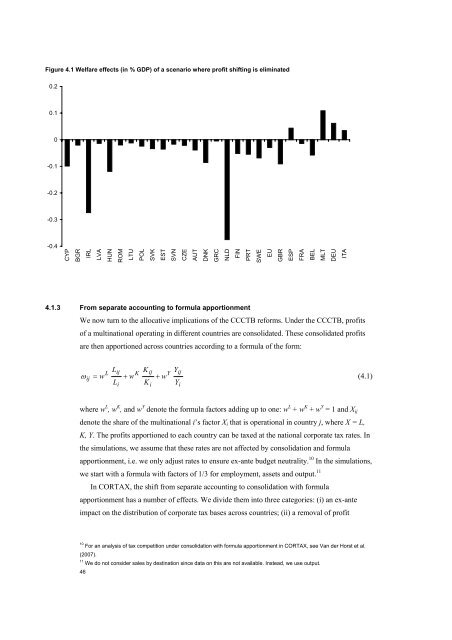The economic effects of EU-reforms in corporate income tax systems
The economic effects of EU-reforms in corporate income tax systems
The economic effects of EU-reforms in corporate income tax systems
Create successful ePaper yourself
Turn your PDF publications into a flip-book with our unique Google optimized e-Paper software.
Figure 4.1 Welfare <strong>effects</strong> (<strong>in</strong> % GDP) <strong>of</strong> a scenario where pr<strong>of</strong>it shift<strong>in</strong>g is elim<strong>in</strong>ated<br />
0.2<br />
0.1<br />
0<br />
-0.1<br />
-0.2<br />
-0.3<br />
-0.4<br />
CYP<br />
BGR<br />
IRL<br />
LVA<br />
HUN<br />
ROM<br />
LTU<br />
POL<br />
SVK<br />
EST<br />
SVN<br />
CZE<br />
AUT<br />
DNK<br />
GRC<br />
NLD<br />
FIN<br />
PRT<br />
SWE<br />
<strong>EU</strong><br />
GBR<br />
ESP<br />
FRA<br />
BEL<br />
MLT<br />
D<strong>EU</strong><br />
ITA<br />
4.1.3 From separate account<strong>in</strong>g to formula apportionment<br />
We now turn to the allocative implications <strong>of</strong> the CCCTB <strong>reforms</strong>. Under the CCCTB, pr<strong>of</strong>its<br />
<strong>of</strong> a mult<strong>in</strong>ational operat<strong>in</strong>g <strong>in</strong> different countries are consolidated. <strong>The</strong>se consolidated pr<strong>of</strong>its<br />
are then apportioned across countries accord<strong>in</strong>g to a formula <strong>of</strong> the form:<br />
Lij<br />
Kij<br />
Y<br />
L K Y ij<br />
ij = w + w + w<br />
Li<br />
Ki<br />
Yi<br />
ω (4.1)<br />
where w L , w K , and w Y denote the formula factors add<strong>in</strong>g up to one: w L + w K + w Y = 1 and X ij<br />
denote the share <strong>of</strong> the mult<strong>in</strong>ational i’s factor X i that is operational <strong>in</strong> country j, where X = L,<br />
K, Y. <strong>The</strong> pr<strong>of</strong>its apportioned to each country can be <strong>tax</strong>ed at the national <strong>corporate</strong> <strong>tax</strong> rates. In<br />
the simulations, we assume that these rates are not affected by consolidation and formula<br />
apportionment, i.e. we only adjust rates to ensure ex-ante budget neutrality. 10 In the simulations,<br />
we start with a formula with factors <strong>of</strong> 1/3 for employment, assets and output. 11<br />
In CORTAX, the shift from separate account<strong>in</strong>g to consolidation with formula<br />
apportionment has a number <strong>of</strong> <strong>effects</strong>. We divide them <strong>in</strong>to three categories: (i) an ex-ante<br />
impact on the distribution <strong>of</strong> <strong>corporate</strong> <strong>tax</strong> bases across countries; (ii) a removal <strong>of</strong> pr<strong>of</strong>it<br />
10 For an analysis <strong>of</strong> <strong>tax</strong> competition under consolidation with formula apportionment <strong>in</strong> CORTAX, see Van der Horst et al.<br />
(2007).<br />
11 We do not consider sales by dest<strong>in</strong>ation s<strong>in</strong>ce data on this are not available. Instead, we use output.<br />
46
















